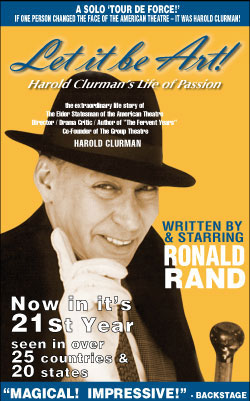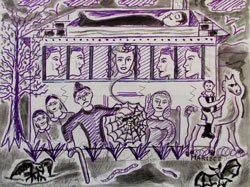Wayne Sides
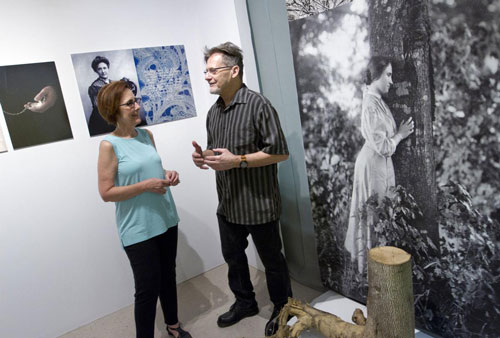
Wayne Sides and Jeanie Thompson at “The Myth of Water” Exhibit at the Helen Keller Public Library, Tuscumbia, Alabama (photo: Florence Times Daily)
Nationally recognized photographer, Professor Sides recently retired as Professor Emeritus at the University of North Alabama in Florence. He had originally studied with Gay Burke, Guy Martin, and graduate work at Pratt Institute. Prof. Sides gained national recognition for his photography in the late 1970’s and 1980’s. He has been recognized for his collaborative work with musicians, poets, and other performing artists and collage artwork. Prof. Sides’ work is in numerous private and public collections and he exhibits and lectures at regional, national and international venues. His art collage/photography installation, “I Wake from a Dream,” with poetry by Jeanie Thompson was on exhibition at the Helen Keller Library in Tuscumbia, Alabama. Mr. Sides’ photographic publications include Sideshow, Litany for a Vanishing Landscape with Jeanie Thompson, White Knights, Silence and the Hammer, and Wayne Sides: Photographs, introduction by Guy Martin. www.waynesides.com
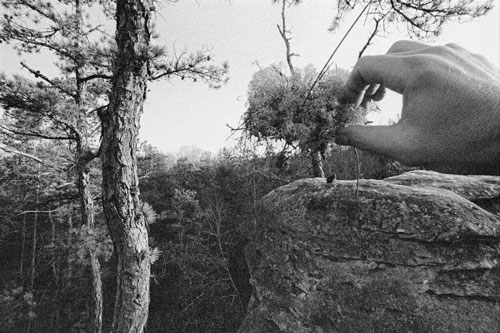
Photo by Wayne Sides
You’re currently working on organizing your vast collection of all the negatives of the last 45 years.
I’ve divided it on my site currently into seven “galleries” of photos, which will evolve as I add new work from the forty years of negatives of my work that I’ve been scanning. It took three years to scan them all. Some of the negatives were lost. It’s really dealing with vintage photographs and trying to create an archive of my work for prosperity, so the site is a real living, breathing entity, with many functions.
The vast majority of the work will be photography, but there will also be texts, symbols and found objects that I’ve incorporated into physical collages. I plan to have a separate section on the site to share images of work that fall into such a category.
I have periodically collaborated with writers and other creatives using my photographs, which I plan to continue. A section will include examples of collaborations and other book-related media with other writers and artists to share my photographic work and highlight their writing and works as well.
The Birmingham Museum of Art have bought a collection of my vintage prints. It all makes me aware of what I’ve done with my life; helps me to move forward to the next chapter, sort of like looking at a road map. Very few artists have that opportunity. I’m really ready to move on to the next chapter my new work.
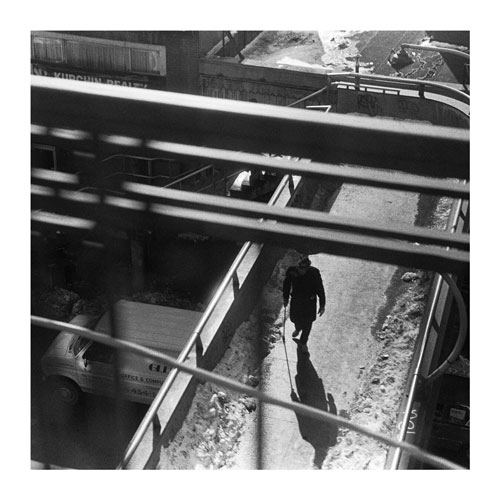
Photo by Wayne Sides
When did you first start taking photographs?
I started out when I was six years old. I used to carry around a little funky camera in the late 1950’s. When I started out in art school, I started out in painting and sculpture and one of my teachers said I really should document my work. I really didn't have the professional equipment, so I finally gave in and bought a second-hand used 35 mm camera at a pawn shop. I started to learn how to develop the black and white photos I was taking. I was doing a lot of collages back then.
When I was in school at Jacksonville State University, they were tearing down a lot of Victorian homes at the time, and I'd come across a lot of interesting things to photograph; I would put some of the shapes up against an old barn, and began to get a lot of interesting black-and-white images. I found shapes had a specific spirit and texture next to each other.
Since I was doing so much photography one of my teachers said: “Why don't you learn about it.” They didn't teach it at school, so I had to get a work study to learn how to do my own developing and printing.
Is that when you studied at the University of Alabama?
Yes, I also took a course on photography in the Art Department is a great experience And I began to understand how to work in a darkroom and to learn all about this art form that's when I transferred to the University of North Alabama and met Gay Burke.
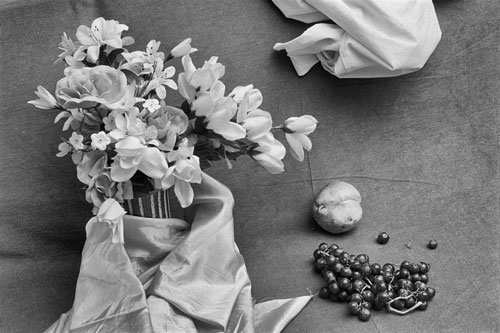
Photo by Wayne Sides
They actually named a grant for her, and I wrote an essay about her. She just passed away and we had a big show for her down in Tuscaloosa, called “The Mother of Alabama Art Photography.” So many people were influenced by her over a period of forty years; She was my teacher, my mentor at the University.
Then I moved to Mobile to become a professional photographer; I also became a private investigator. While I was down there, I took a minor in Theater at the University. I was there because my girlfriend at the time suggested we move there. I wanted to get involved in the arts, so I started working for theatre groups documenting actors, childrens theatres during their rehearsals. I photographed a season at a summer stock theater, and actually began acting in musicals at a dinner theater.
This was on the Eastern shore, and at the same time Columbia Pictures came to town. Steven Spielberg came to film a science fiction film called “Close Encounters of the Third Kind.” It was going to be the most expensive science fiction movie ever made up to that time.
Now a friend of mine at the University got me involved in the dance department; I needed to take one more course, so I took choreography. My teacher, Lou Walls, had studied with Martha Graham, and got me involved with the dance company. They had a dance company that traveled around performing called the University Dancers, so all of a sudden, I was one of the two male dancers in the company.
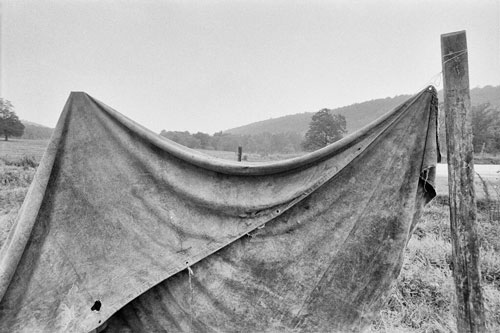
Photo by Wayne Sides
I had found out Spielberg was looking for mimes, so I went looking for work and was hired, and worked with the choreographer and the stunt men on the film.
Buddy Joe Hooker, the famous Hollywood stunt man, created all the pratfalls of the aliens, with the technicians working on the film. So, we would do the action in slow motion since they were running the camera in one speed, and the little aliens had to appear they were running faster. So that in the takes, it actually looked like they were moving fast.
After that, I ended up in Decatur as an artist-in-residence and helped start a community theater group – Bank Street Players – and it’s still going today. After that, I actually started a theater group at the Austin High School.
The whole time I was teaching theater and art in different schools and in the meantime for my own work, I was haunting different places and interested in local scenes in Southern culture. I went to a huge state fair in Birmingham, and in one of the last big tents, I approached a statue, it was of the Klan and they thought I was with the Press and wanted some of the photographs I was taking. So, I got in touch with them and that led to me photographing them for the next four years.
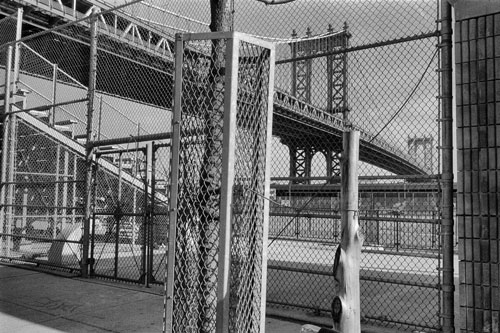
Photo by Wayne Sides
You went on to gain national recognition for your photographs of the Klan. How were you able to take all these photos at the rallies?
Everyone who took photos like these were considered a photojournalist, but that wasn’t who I was. I was really taking these photos, more for historic purposes, and I really didn’t know how they’d turn out.
One of those years I was in Blount County. I was a Resident Artist teaching at a college, in the coal mining area in the foothills of the Appalachian Mountains, above Birmingham, Alabama.
That was the first place when I found the Klan. Some of them were coal miners. I hung out with them until I ran into another group in Athens. I’d go to the rallies and take photos. I had been teaching, and one of my students recognized me and vouched for me as their teacher, so I was “okay.” That's basically how I was able to stay and attend the rallies and take photos.
There were times when I could have had real problems. Luckily, the students got me out of trouble several times. A lot of time, the Klan members had loaded guns, and I’d get pushed and shoved, and I’d have to talk my way out of a lot of sticky situations.
I got some good advice. I was told to bring a woman with me to the rallies; it would “soften everything up.” So, I did, and it worked, and they would talk to her, and it wasn’t near as confrontational.
Looking at the photos I took back then, it was of sort of like the way Bob Dylan had started out in Greenwich Village. During that period of time he said he didn't really know what he was doing but he was doing something no one else was doing; it was sort of like a ‘perfect storm.’
At that time, I was ‘hungry’ to do something like that. Basically, I didn't know you couldn't do what I was doing. I really had no fear, sort of like a war photographer who doesn't get frightened until it's over and then you look at the images and you wonder how I couldn’t have been frightened? But I was “in a zone.”
In a sense, I was sort of discovered, much like Andy Warhol was, when they showed his artwork at the O.K. Gallery. While I was at Pratt Institute in New York City, I decided to take my photos and walked into O.K. Gallery in Soho. Ivan Karp was there, and I told him I had taken all these photos and he took a look at my collection.
Now, Ivan Karp was the same guy who helped get Andy Warhol, Roy Lichtenstein and Robert Rauschenberg discovered. He focused on photorealism artists like Robert Cottingham, Robert Bechtle, Deborah Butterfield, Malcolm Morely and Duane Hanson.
So, he’s looking at my photos, and I had thrown in some of the Klan photos I had taken. He sees them and he says: “This is what you need to do more of. I want to see more of these.”
That was very encouraging. So that’s what I did; I put all of my soul into that effort. As soon as I got back to the South, I put together a lot more of the Klan photos I had taken and when I went back, I showed them to him. He told me when he was looking through my work, it sort of reminded him of the first work that Andy Warhol did; it was very raw.
Warhol had taken a lot of photographs of well-respected politicians when they had been arrested and lined them up on a large wall like they were mug shots. He said: “Your work has a certain starkness, a grittiness like Andy’s. I liked all the imperfections.”
I really didn’t know what I was doing. I had never done this kind of photography before. There really wasn't much light when I was taking the pictures but he said: “I'm going give you a show.”
That’s when I had my first show at the famous O.K. Harris Gallery in New York. I was studying at Pratt Institute, and had this big show while I was still going to college. After that, when I came out of art school, I started looking for subjects.
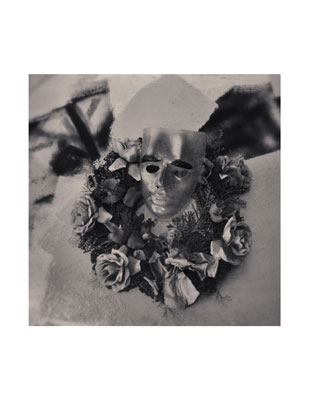
Photo by Wayne Sides
How did you get to know the renowned photographer, Walker Evans?
When I was studying photography at the University of Alabama, there was a day when we were told that Walker Evans may come to the University. William Christenberry, a great photographer in his own right, was one of my teachers. He had met Walker and brought him back to Tuscaloosa to go and look at some of the places that he had originally photographed.
So, this day I walk into class and there’s Walker Evans sitting in my seat. I was the only one who had brought a camera to class that day because it was a critique day but I had my camera with me. So, Walker is sitting there with Gay Burke and William Christenberry, and I photographed all three of them in the same shot, and that photo ended up in a lot of books. I got to talking with Walker about my work and he critiqued and discussed my work.
Now, the Polaroid sx70 instant color camera had just come out and they got a hold of several of the famous American photographers to try it out. They had given Walker one, and I’d see him running around, this a little old man with a white beard stepping out between buildings and taking a lot of the photographs.
He had become famous for his photographs during the Great Depression in the 1930’s. He captured the great southern experience of the tenant families and sharecroppers in Southern Alabama. Walker was one of the first to have the ability to pull in all these wonderful compositions. His photographs look like collages, there were people, furniture, landscapes, and they looked like puzzles. And they were pleasing to look at in an intelligent composition. A lot of painters were influenced by him, Pop artists like Jasper Johns would look at his work for inspiration.
Artists are always inspired by those who have come before them. We step onto their shoulders, actors, singers, everybody has someone to look up to.
And then I discovered Diane Arbus; she was another inspiration for me. She photographed the bizarre, so I was trying and put these two together. When I ran up against the Klan, I had Walker and Diane Arbus in the back of my mind.
Diane Arbus’ focus were dark subjects, the nitty gritty world of common people, in her own words, of people who have already earned the place at the top because they had been looked down upon – dwarfs, midgets, transvestites…
So, I was haunting these fairs, coming upon carnivals workers, people who when you looked at them had stories to tell. That’s when I came upon the Klan exhibit; it fell together in my head. I decided to ‘marry’ the sensibility of Walker Evans with the bizarreness of Arbus and make my own art out of it. To see if I could freeze that moment in time as if a spotlight had fallen on it.
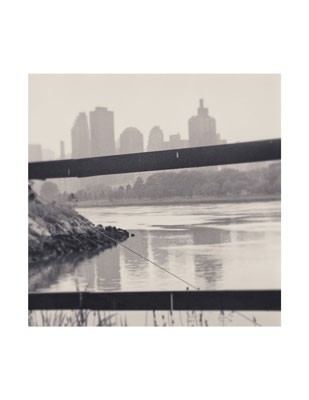
Photo by Wayne Sides
How would you describe the skills and aesthetics that a photographer needs to acquire to grow in their work?
It was a totally different “animal” back when I started. Photography was almost basically the same that it was in the late 19th century. We were all pretty much using a lot of the same tools we used for black-and-white wet photography. You had to be bit of a chemist to understand it all to work in the darkroom. It’s what I learned and it’s what I taught.
Today, any student in high school student can go to Walmart and get what they need, plug in a computer and pretty much become a photographer.
Back then, it was a lot more difficult and you were restricted by your budget and the cost of the film. That was a whole different ball game, but skills are skills and you’ve got to understand the skills that are required and learn the camera’s “bells and whistles” to use it properly.
Back in those days you were really trying to see what the image was and try and capture it and I really didn’t know a lot about lighting. Everything changed with Photoshop. Now everything is taught through online courses, and it’s all laid out in front of you.
You’ve also had a special collaboration working with the poet, Jeanie Thompson, including working on “Vanishing Landscapes.”
I’ve always enjoyed collaboration, going back to my days in sports in track and football. When you're working with another individual you can get so much more done between using both of your brain power and ideas.
I started working with Jeanie a long way back in college, on other projects. And over the years, I've also worked with a lot of musicians and other artists on different projects. When Jeanie and I decided to work on the project about vanishing landscapes, it also involved our pulling in as many folk artists as we could find for two years. We’d add things to the show as we traveled together.
She’d see something in the environment and write a poem, and I’d respond to it and I’d take a photograph, or I’d create an art piece, and she'd respond to it with a short essay or a poem. It's a great way to tell stories.
I’d tell her stories about my upbringing and she’d respond to them with a poem, and we find these abandoned houses traveling together and we make collages together.
What drew you specifically to work together to bring Helen Keller’s story to an amazing ‘living and breathing’ installation, “The Myth of Water,” at the Helen Keller Library?
Jeannie had written her poems for a new book and she wanted us to work together. I did the book cover. She had gotten a residency, and I asked her to let me take look at her poems, to let me hear her voice. So, she sent me some tapes. I thought she was doing a whole new take on Helen Keller’s life.
I started doing a lot of research, and started taking photographs, crawling around Ivy Green, Helen Keller’s birthplace. I took some historic photographs of the area, some new things I hadn't taken before, trying to capture the essence and spirit of Helen Keller’s poems, and with Jeanie’s poems, try and put them together with the photographs and collages.
So, as Jeanie and I talked together, we talked about stepping inside Helen Keller’s skin, about what Helen Keller might have thought about, what she was thinking when she was a young girl standing at the pump at Ivy Green with the water flowing over her hands.
And later on, when she was a middle-aged woman and became an Ambassador. What happened during those years fascinated me.
Helen Keller is really a really a miracle of a woman; she was blind, deaf and dumb and accomplished so many things. I thought about what it might have been like to be in that ‘dark world’ of Helen’s, trying to cope with darkness and light.
Light is everything to a photographer, and I wanted to try and capture that spirit of that ‘light,’ that essence in the art pieces that I put in the show. The ‘light’ that was in her inner self. You see it in all of her pictures; she really beams with this light.
I’d sit somewhere and something would illuminate to me who she was, what she was thinking and, of course, I was inspired by Jeanie’s work and her poetry. And when you’ve got somebody like Helen Keller, you have this amazing human being to draw from. I feel so honored, so lucky to have had the opportunity of being from Alabama and working on an exhibit about Helen Keller.
Would you say, everything you’ve gone through in your life, up to this point, has given you a rare insight to go further now as an artist?
Definitely. All the experiences I’ve gone through all these years have given me the tools to move forward. I feel so much freer than before. I felt a little tied to doing photography the proper way but now the pressure’s been lifted off and I can move back and forth into a more of a three-dimensional art form.
Before I was known really as a photographer and they wouldn't accept that I was more of an artist using photography. Everything up to now has allowed me to bring this collaboration of all of the things I’ve learned into my work now. And my training in theater has helped me so much in the collages I’m doing today. They’re like vignettes, little theater pieces, like a performance on a little stage.
When I’m working I allow something else to take over and I step inside a ‘zone.’ I’ve also been blessed to collaborate with so many different wonderful artists which have made me what kind of an artist I am and who I am.









































